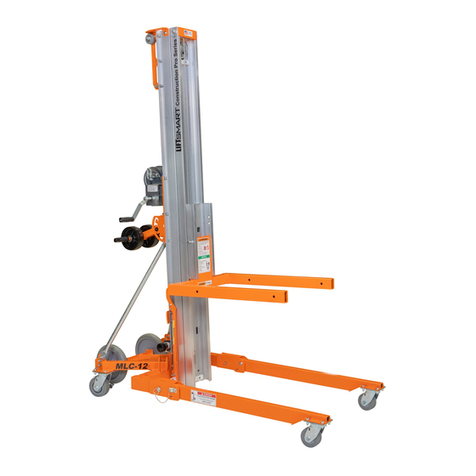ANNUAL INSPECTIONS
Lubricate the Casters and Wheels.
Perform the following inspections annually.
Perform these inspections in addition to all daily
and quarterly inspections.
It is important to lubricate casters and/or wheels for
a proper use of the product and to extend its
service life.
❑Inspect the wheels and casters for cracks or
cuts and excessive wear.
❑Lubricate the casters and wheels:
•Using the Zerk fittings, add lithium-based
grease into the bearings of the wheels
and casters until it becomes visible at the
bearing gap.
❑On a level surface, push and steer the
material lift to make sure casters and wheels
roll effortlessly.
Inspect the Painted Surfaces
A visual inspection of the painted areas will assist
in recognizing potentially damaged areas of the
material lift, which will need to be corrected for the
continued safe use of the machine.
❑Visually inspect the painted surfaces of the
material lift for blisters, peeling, rust, fading or
corrosion.
Inspect the Hold Down Bar
Unsafe work areas occur when damage to the MLC
Construction Pro Series is not discovered.
❑Visually inspect the Fork Carriage and Hold
Down Bar.
❑Check if the Hold Down Bar is operating
correctly.
NOTE: The Hold Down Bar is operating correctly
when it does NOT overstroke the top of the Fork
Carriage and when it prevents the telescopic
mast assembly from extending when the mast is
parallel to the ground.
Inspect the Pulleys, and Cable
This inspection should happen at least annually.
Failure to check the sub-components of the
material lift can lead to serious injuries or even
death.
NOTE: Due to visual obstructions the mastmust be
disassembled to properly and fully inspect the mast
rollers, pulleys, and cable.
1. Disassemble the Mast (refer to related
information in Section 4 of this manual).
2. Inspect the Cable, Pulleys, and related sub-
components and look for the following issues:
▪Kink(s) in the cable.
▪Broken wires.
▪Corrosion.
▪Cracks in the swaged cable end.
▪Damaged pulleys and pulley mounts.
▪Mounting plates are firmly secured.
3. Inspect Mast Rollers (refer to related
information in Section 4 of this manual).
NOTE: If something abnormal or damage is
located during the inspection, remove the
Material Lift from the workplace immediately.
4. Re-assemble the Mast (refer to related
information in Section 4 of this manual).






























